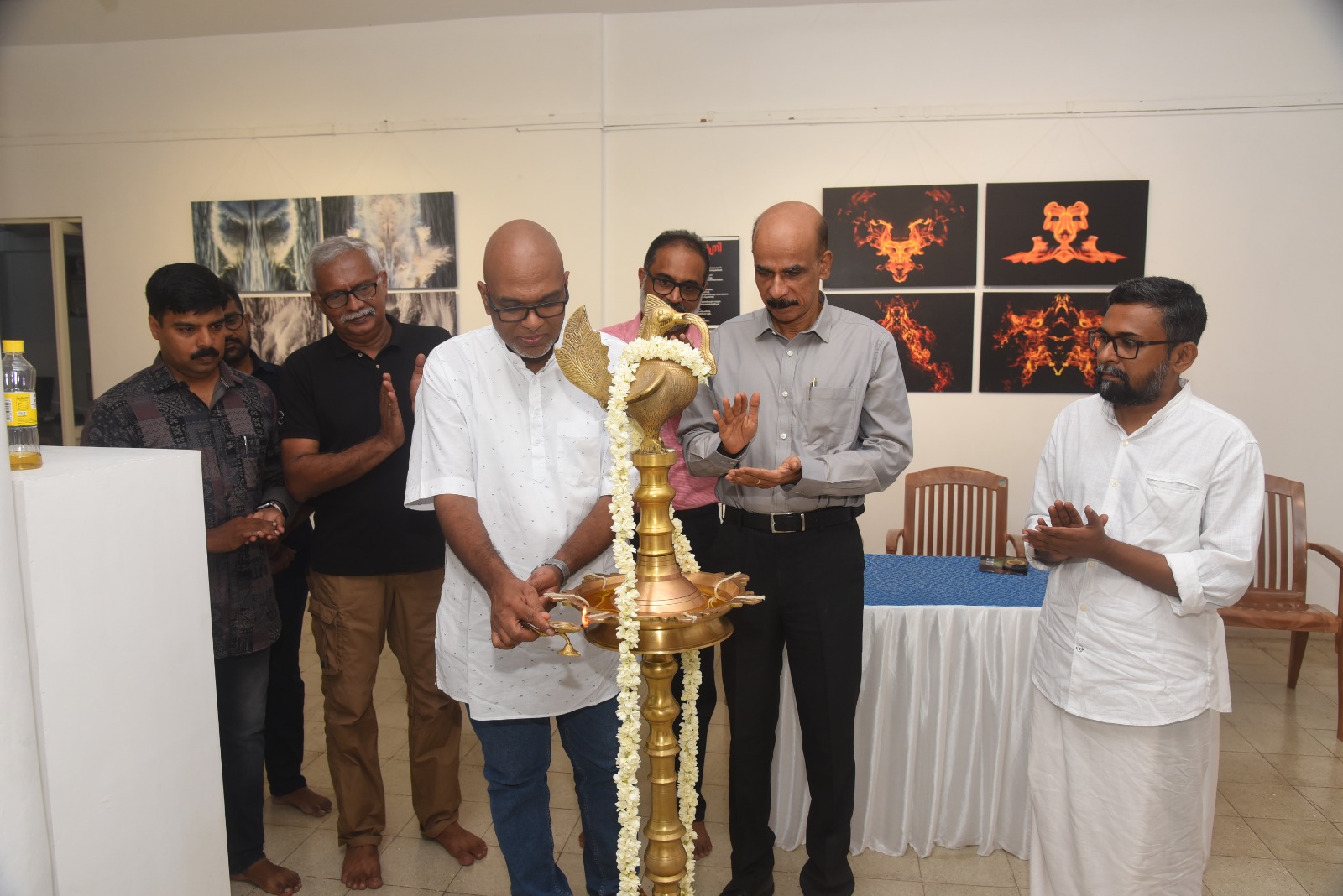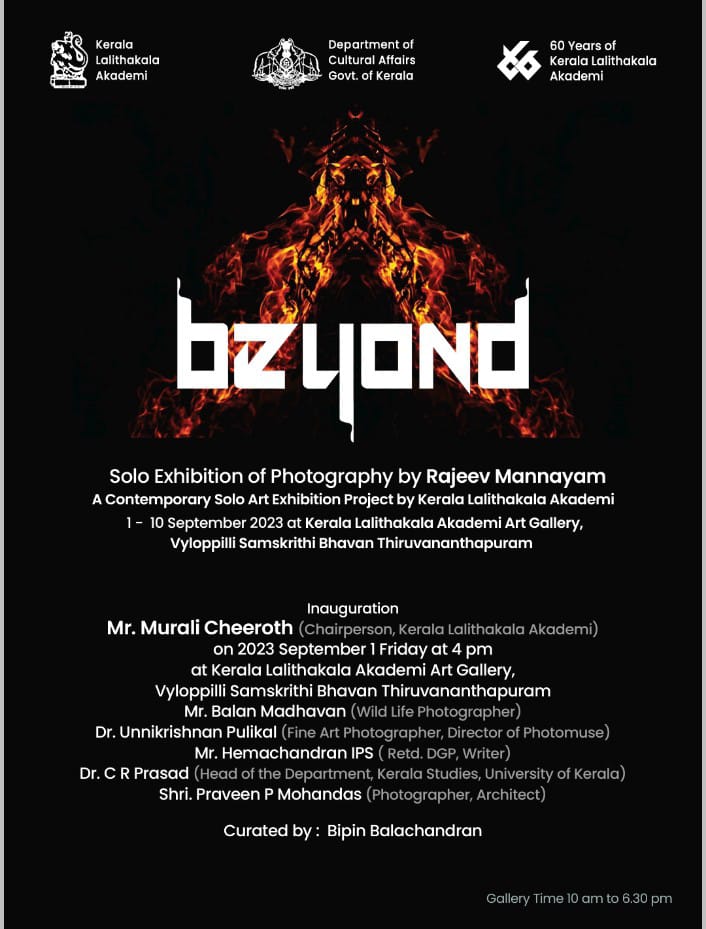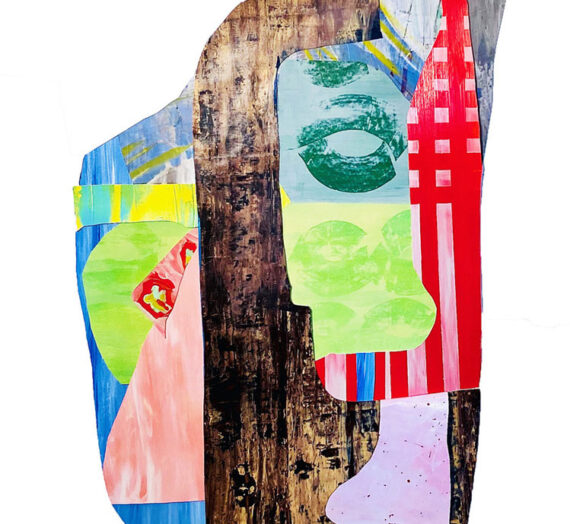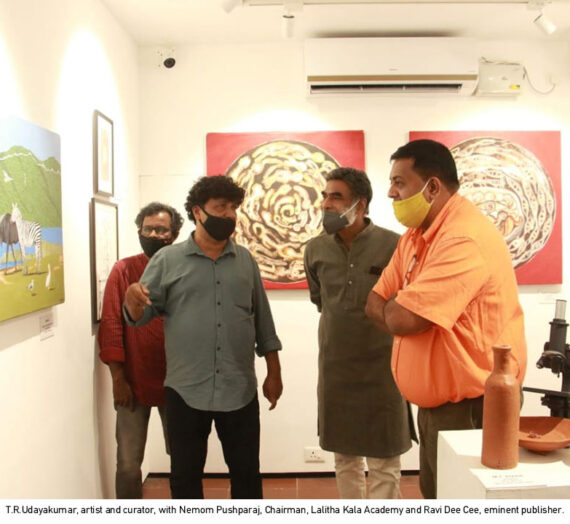The Photographic ‘Truth’ and Beyond
A Contemporary Solo Art Exhibition Project by Kerala Lalithakala Akademi Solo exhibition of Photography by Rajeev Mannayam
“One should not only photograph things for what they are but for what else they are” (t) The joy of photographing in the light of the sun is balanced by the joy of editing in the light of the mind
-(Minor White)
The invention of photography in the early 19th century revolutionized the way humans perceive and interact with the world around them. What began as an innovative technique for capturing accurate visual records has gradually evolved into a multifaceted medium of artistic expression. The birth of photography is credited to Louis Daguerre’s daguerreotype process and William Henry Fox Talbot’s calotype process in the 1830s. These early techniques laid the groundwork for photography’s evolution as both a scientific tool and an artistic medium. The daguerreotype’s impeccable detall and the calotype’s reproducibility set the stage for the subsequent exploration of photography’s artistic potential. As photography gained traction, some artists sought to move beyond mere documentation and embraced photography’s potential for creative expression. The Pictorialist movement emerged in the late 19th and early 20th centuries, characterized by manipulated Images that resembled traditional paintings. This movement blurred the lines between photography and painting, challenging the conventional understanding of artistic mediums. The early 20th century witnessed the emergence of Modernist photography, with practitioners like Edward Steichen, Alfred Stieglitz, and Paul Strand championing photography’s unique qualities. By embracing abstraction, geometry, and experimental techniques, these photographers elevated photography to the status of fine art, emphasizing individual expression over mere representation.
Traditional photography was predicated upon the chemical process of capturing light on photosensitive materials, resulting in singular, immutable images. Digital photography, however, operates on a fundamentally different principle – the conversion of light into digital data. This departure has led to the decoupling of image and physical substrate, allowing for the manipulation, reproduction, and dissemination of images without loss of quality. This dematerialization of the image challenges the traditional photographic concept of indexicality, where the photograph was seen as a direct trace of reality.
Cognizance in Abstraction
The malleability of digital images presents a departure from traditional representational veracity. The ease of manipulation, retouching, and compositing in digital photography blurs the line between the real and the fabricated, raising questions about the authenticity of images. The visual narratives constructed through digital photography call into question the very epistemology of photographic truth. The epistemological transformations sparked by the advent of digital photography have echoed throughout the domain of art. Artists who were previously bound to conventional photographic methods now adeptly wield digital tools to fashion inventive visual experiences. The trend of photographers Increasingly identifying as artists is on the rise. Exemplifying this transformative trajectory is the exhibition Atheetham, by Rajeev Mannayam, an impassioned practitioner of photography. Within this artistic opus, Rajeev’s profound engagement with the medium materializes into a vivid embodiment of his artistic persona.
Rajeev employs a meticulous approach in constructing his compositions, wherein he Incorporates by choice mirror images of his abstract photographs alongside their originals. This deliberate juxtaposition engenders intricate patterns and discernible forms within the visual framework. Rajeev’s art, characterized by its departure from realistic representation, taps into the human mind’s proclivity for pattern recognition. The artist intentionally creates compositions that trigger the brain’s pattern-detecting mechanisms, inviting viewers to perceive hidden connections and structures within apparently non-representational arrangements. Hence, Rajeev’s artistic pursuits strive to recalibrate the interrelationship between aesthetic encounters and the realm of the transcendental.
Rajeev’s ability to blend the technical aspects of photography with emotional and spiritual depth, in some sense evokes a semblance to the captivating works of Minor White. An esteemed American photographer and educator, White subscribed to the notion that photography serves as a vessel for delving into internal sentiments and spiritual facets of the individual. He masterfully interwove his imagery with symbols, abstract configurations, and enigmatic connotations, thereby encouraging viewers to engage with his work on a deeper level, in a prefatory remark accompanying his exhibition, Rajeev elucidates, “Reductionism becomes manifest when one’s worldview is confined to the materialistic, encompassing only phenomena susceptible to rational interpretation.” For Rajeev, artistic creation unfolds as an extensive realm of ineffable essences and notions, conjuring a dimension that surpasses conventional comprehension. He prefers to refer to his mirror images as a fusion of rationality and imagination, implying that these aspects are not mutually exclusive but jointly contribute to the formulation of human perception of the world.
The human capacity to perceive patterns in abstract forms and construct narratives is rooted in the foundational principles of Gestalt theory, revealing an intricate interplay between cognition, perception, and artistic engagement. Gestalt theory posits that the human mind innately organizes visual stimuli into coherent patterns, structures, and wholes. This holistic approach to perception underscores the tendency of the brain to synthesize elements into uni ed forms. Gestalt principles such as proximity, similarity, continuity, and closure guide our perception, enabling the recognition of patterns even in the absence of explicit referents.
Rajeev’s photographs, often devoid of concrete representations, taps into the Gestalt-driven human inclination to perceive patterns and wholes. He deliberately composes his works such a way that trigger the brain’s pattern recognition processes. As the brain pieces together perceived elements into meaningful wholes, it concurrently constructs narratives that imbue the abstract forms with context and coherence. These narratives, informed by personal experiences and cultural frameworks, enable viewers to derive emotional resonance and comprehension from abstract art. Notably, contemporary advancements in the realms of cognitive linguistics and neuroscience substantiate and enrich this perspective. Evidently, the seminal contributions of distinguished cognitive linguist George Lakoff furnish an overarching paradigm that expounds upon the intricate interplay between language, cognitive faculties, and human mentation. Lakoff’s introduction of “image schemas, elemental templates rooted in sensory-motor modalities, serves as foundational pillars underpinning abstract ratiocination. In alignment, the conceptual apparatus of “frames elucidates the cognitive infrastructure facilitating the organization and Interpretation of informational content through the prism of familiar contextual frameworks. Furthermore, the mechanics of “conceptual metaphors” manifest as a cogent elucidation of the cognitive process wherein apprehension of abstract notions is Inherently intertwined with more palpable experiential matrices.
Here, the interplay between Gestalt principles, pattern recognition, and narrative construction enriches the viewer’s cognitive engagement with these photographs, conveniently grouped into the thematic categories of Fire, Sky, Earth, Air, and Water-echoing the quintessential Indian philosophy of the ve elements. As the mind uncovers patterns and weaves narratives, it actively participates in the aesthetic experience. The artist’s intention, the abstract form, and the viewer’s cognitive processes coalesce, leading to a dynamic exchange of interpretation and emotional resonance.

Left to Right:- Rajeev Mannayam, Praveen Mohandas, Balan Madhavan, Murali Cheeroth, Dr. C R Prasad,
A Hemachandran IPS, Bipin Balachandran
Author
Bipin Balachandran (Art critic and Writer)





Leave a Reply